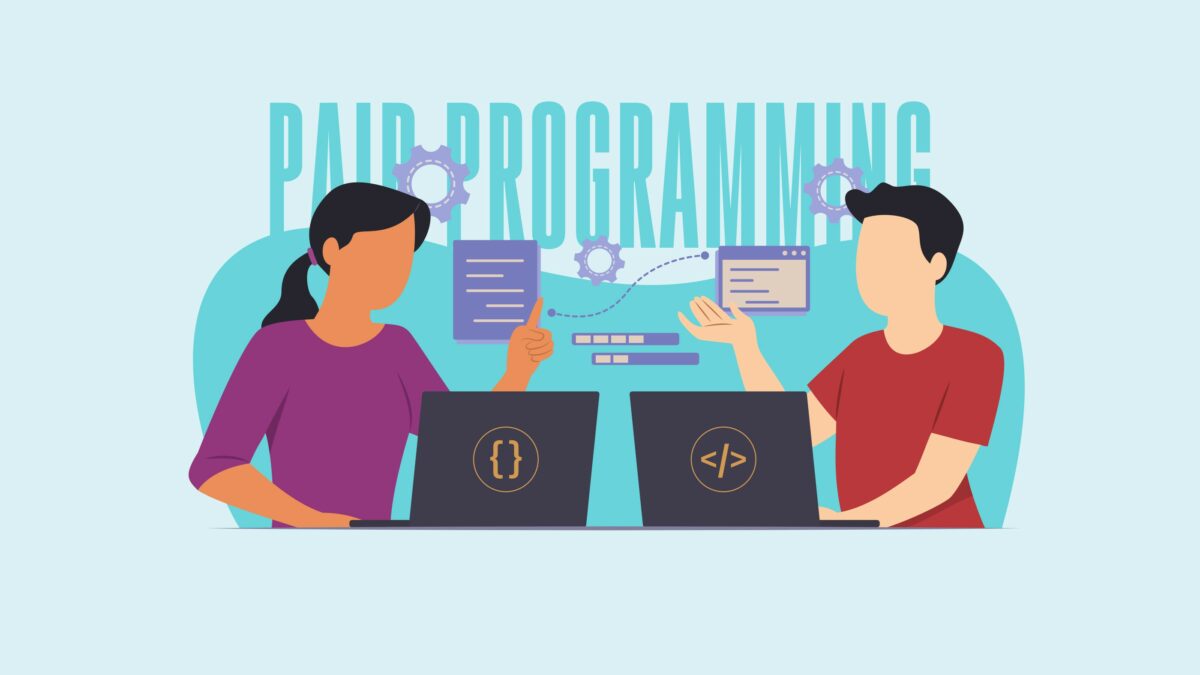Programming and development is a minefield of complexity, creativity, and technology. When a business problem needs solving, it often falls to these hardened defenders of the code to find a solution and save the day. Without the expertise of trusted developers, our entire digital ecosystem would fall into disrepair — it may have never even been made.
Still, for the incredible importance of these individuals in business structure, all too often the work itself can be pushed to the side, leading to isolated individuals tackling huge problems that require more resources than they’re given. While there have been a host of strategies to alleviate this, pair programming is emerging as a panacea to the many issues that have plagued programming teams for decades.
What is pair programming?
Pair programming is the approach of creating duos of programmers to tackle a specific project or task. They will work collaboratively to develop the code and tackle any problems faced and will work simultaneously towards the end goal. It is a simple concept in truth and can be modified to suit your development team too, making it a flexible approach to development that has grown in popularity over time.
Pair programming can be employed in development teams of all sizes, from start-ups with fewer than ten employees to huge businesses that routinely have enterprise meeting sessions of dozens of team members.
With that said, the concept does invite a host of questions such as how is the work achieved without stepping on each other’s toes, what is the best approach to establishing a pair programming strategy, and is it even beneficial to apply two individuals to work on one problem? We’ll answer these below and explain the key bits of info you need to know.

5 things to know about pair programming
As adaptable as the concept is, there are a series of established ideas that most pair programming arrangements will adhere to.
There are 3 maExpert – Expertin styles to consider
The vast majority of pair programming setups will fall into one of three main methods — ping pong style, unstructured style, and the driver-navigator approach. Each of these methods has advantages and disadvantages, so it’s worth exploring each to determine what works best for both the individuals and your business.
- Ping-pong style
Ping-pong programming focuses on having developers push each other forward with a series of rotating test-based development. Once the problem has been identified and the requirements to resolve it established, one developer will create a test to benchmark successful code commits against. The other developer will program in accordance with those tests and seek to pass them. As the codebase matures and the tests are passed, they can swap roles and work towards a new goal.
This is a great approach to ensure both developers are engaged and are working productively, though the time taken to complete tasks may be longer than other approaches.
- Unstructured style
An unstructured style is pretty much what you’d expect — no-holds-barred collaborative development. Programmers are given the autonomy to determine how to best tackle the project and can create code in tandem or in silo of one another, however suits them best.
While this can be a superb way of tackling complicated issues that require two sets of eyes, it can also lead to mismatched inputs and a loss of engagement if one developer outshines the other.
- Driver-navigator approach
In this style, developers take two distinct roles. The driver creates all code and contributes the direct work, while the navigator will critique, examine, and help propel the driver forward in their efforts.
For example, the navigator might research information — such as seeking to define ERM at the driver’s request in relation to the task they’re working on — or solutions to an impending issue while the driver continues making progress elsewhere. This helps ensure that work is always moving forward and that both developers feel supported. Roles will often swap over the course of a project, especially when areas of expertise present themselves and an individual can tackle them.

Different pairings can lead to different results
The pairings of developers will have a marked impact on how a task and the individuals will progress. Most developer partnerships can be identified as the following:
- Expert – Expert
Ideal for highly complex tasks that require vast amounts of knowledge or expertise to accomplish. Both developers will be highly skilled and can support each other in creative problem-solving and collaborative contribution to the codebase.
- Expert – Novice
Ideal for medium-scale projects where both developers can partake in contribution and the senior developer has room to educate and monitor output before task completion. The novice benefits from expert guidance and support, while the expert gets the opportunity to educate and support another team member.
This pairing is particularly effective when aiming for a minimum viable product, as the expert can guide the novice in focusing on essential features and functionalities to deliver a functional solution efficiently.
- Novice – Novice
Ideal for simple or low-priority projects, where junior developers can spend time learning and growing with each other to resolve the issue. Best used as part of onboarding activities and training exercises, such as exploring the differences and benefits between Spark vs PySpark.
Depending on whether you need absolute precision within a project or want to create learning opportunities for the team, pairing your developers correctly is a key part of effective pair programming management.

Pair programming can boost morale while speeding up projects
Let’s say your development team is tasked with building a framework allowing for artificial intelligence in customer experience monitoring, and a series of required functions are outlined — live monitoring of data, and export tools for third-party manipulation at a minimum. A project of this scope might seem unmanageable for an individual to tackle, but a pair of expert programmers can work together to break it down and succeed.
The morale boost from working together cannot be understated, especially when things get challenging, and there will be time saved from having additional resources working on a task. In many cases, simply having support when facing difficult circumstances can be the difference between success and failure.
Additionally, with the right infrastructure, like dedicated hosting, teams can ensure consistent and reliable performance, even when working remotely.This is particularly crucial for industries such as finance, where data security and confidentiality are paramount concerns. Therefore, pair programming becomes an indispensable strategy for a finance software development company, ensuring both efficiency and security in collaborative coding efforts.
Pair programming can work remotely with the right tools
With modern technology, it’s incredibly easy for developers to work remotely and still work in pairs contributing to a shared codebase, communicating effectively the whole way. While it is still recommended for teams to work side-by-side when contributing to a single resource, remote working provides a viable alternative that supports modern practices in 2024.
There are several tools that can help facilitate quality output, such as robust communication tools — shared or remote desktop access, screen sharing capabilities, and reliable text and voice communication apps all help to build a seamless experience for developers working as a pair.
Additionally, it’s essential to prioritize security measures, including DMARC compliance, to ensure the protection of sensitive information and maintain a secure development environment. This helps prevent email spoofing and phishing attacks by allowing domain owners to specify how their emails should be authenticated and handled by receiving mail servers.

Not every pairing is going to work out
The unfortunate truth is that everyone isn’t always going to get along. Some personalities clash, and some methods of working won’t lead to an effective partnership. Instead of pushing the issue, if you see problems arise then act to make a change.
This can present itself in stagnation on a project, low output, complaints from a team member, or a lack of contribution by an individual. Always monitor these factors to ensure that everyone is happy and working towards a common goal.
How can pair programming be helpful?
Much in the way that AI in communication appears magical in its ability to transform internal and external comms, an established development pair is capable of programming wizardry they’d be unable to achieve alone.
Think of pair programming as a force multiplier to expedite projects, as a method to train individuals in a real-world environment, and to learn more about your individual developers themselves and their capabilities. It’s a flexible tool to help break programmers out of ruts, promote their personal development, and let them showcase their creativity in a supportive atmosphere.

Can pair programming be harmful?
There are some risks to consider when actively pursuing a pair programming approach. Many of these can be mitigated with proper care, and some will only arise when the pairs themselves are not working effectively.
The main challenges to be aware of include:
- Increased cost per project
- Lengthier time to complete some projects
- Less capacity to tackle multiple projects
- Internal conflicts
As long as you monitor your teams closely, the above issues can be largely sidestepped, and the benefits of pair programming can truly shine.
The next steps
Start thinking about how you can implement pair programming strategies into your upcoming projects. If you have reports of stalled development or frustration from individual programmers, that’s the perfect time to explore pair programming and provide a fresh approach for the team to get involved with.
Always remain attentive and agile in your actions when managing pairs. If they’re unhappy or ineffective, don’t be afraid to switch things up and keep changing the dynamic. When things start working, that’s your cue to step away and let them get on with the task at hand. Pair programming can help breathe new life into tired development processes and get teams working creatively again.
Bio:

Jessica True is the Senior Director for Marketing Strategy and Operations at Dialpad, a modern business communications platform that takes every kind of conversation to the next level—turning conversations into opportunities. Jessica is an expert in collaborating with multifunctional teams to execute and optimize marketing efforts, for both company and client campaigns. Here is her LinkedIn.

